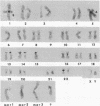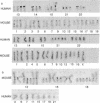Abstract
Most mouse-human somatic cell hybrids show preferential loss of human chromosomes, absence of human 28S ribosomal RNA, and suppression of human nucleolus organizer activity, as visualized by the Ag-AS silver histochemical stain. In contrast, the mouse-human hybrids studied here show preferential loss of mouse chromosomes. The hybrids were made by fusion of HT-1080-6TG human fibrosarcoma cells with BALB/c mouse peritoneal macrophages or strain 129 mouse teratocarcinoma cells. The Ag-AS staining method shows nucleolus organizer activity of chromosomes 13, 14, 15, 21 (rarely), and 22 in the human parent and chromosomes 12, 15, 16 (rarely), and 18 in the BALB/c mouse parent. In the hybrid cells the human nucleolus organizer regions are active, as shown by Ag-AS staining and involvement in "satellite association." The mouse nucleolus organizer regions are not stained by the Ag-AS method even though mouse chromosomes 12, 15, and 18 are present in the BALB/c hybrids and at least one copy of each mouse chromosome is present in the teratocarcinoma-derived hybrids. Thus, in these mouse-human hybrids, unlike those that lose human chromosomes, only human nucleolus organizer activity is expressed, and mouse nucleolus organizer activity is suppressed.
Full text
PDF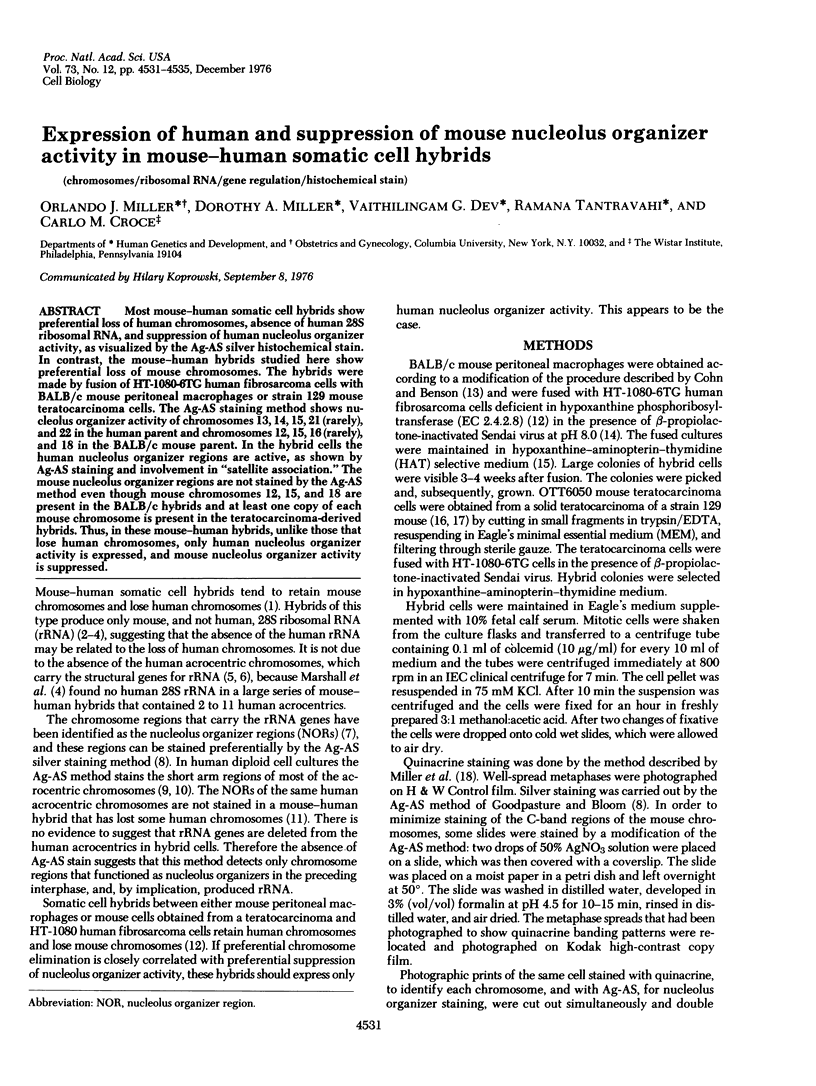
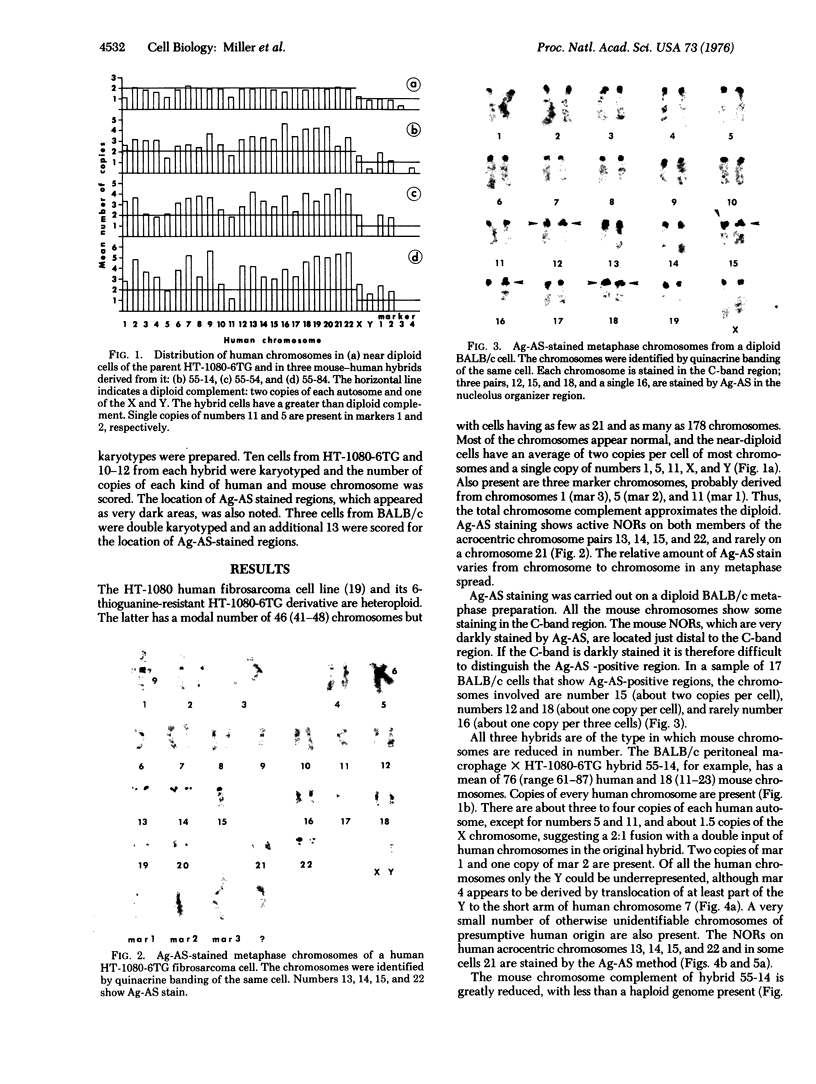
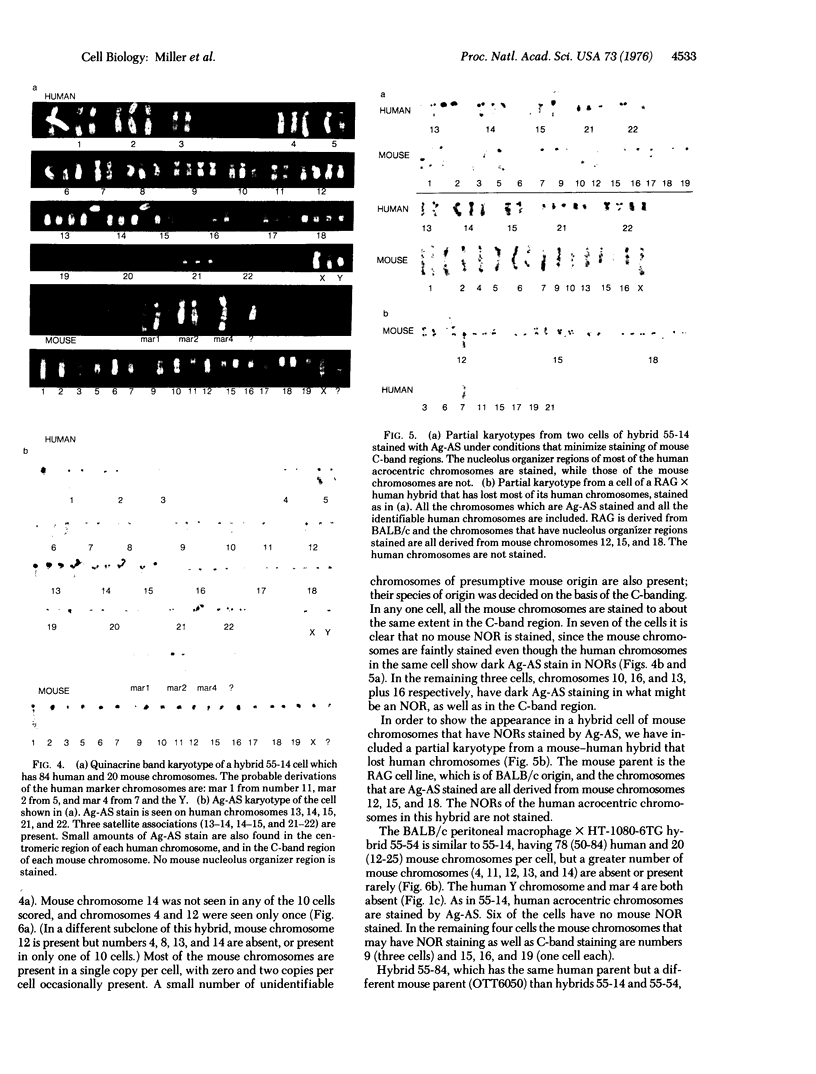
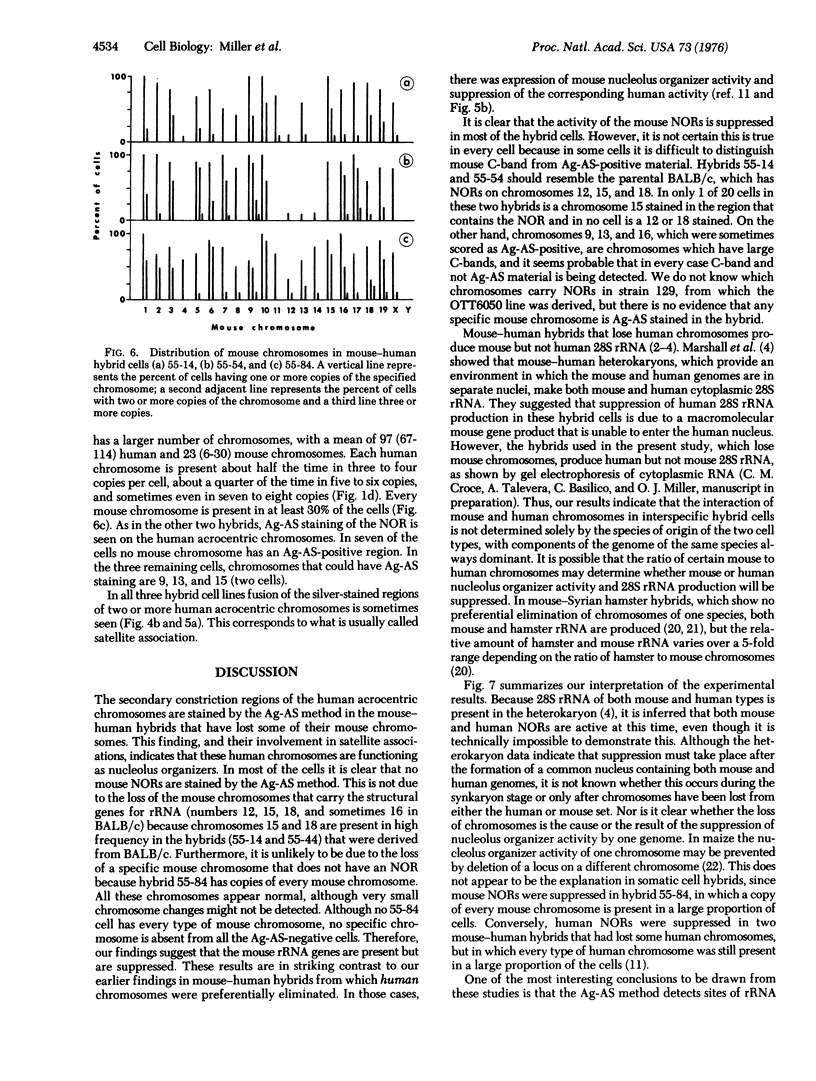
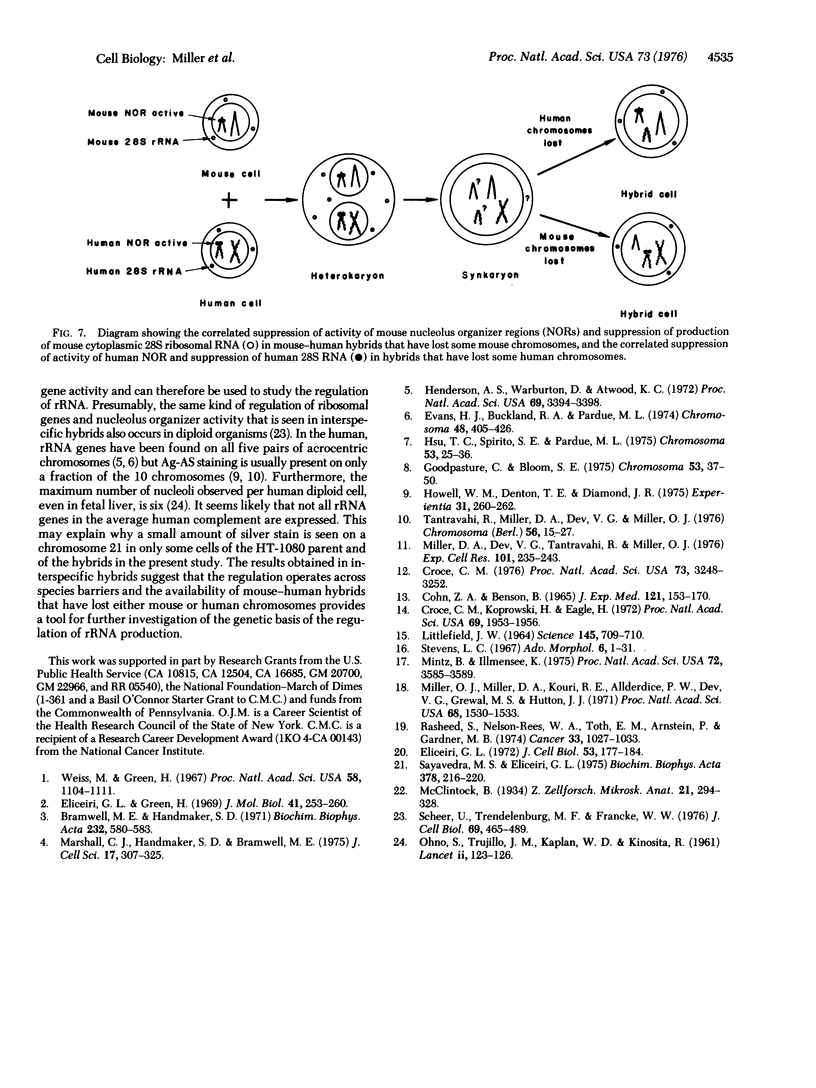
Images in this article
Selected References
These references are in PubMed. This may not be the complete list of references from this article.
- Bramwell M. E., Handmaker S. D. Ribosomal RNA synthesis in human-mouse hybrid cells. Biochim Biophys Acta. 1971 Mar 25;232(3):580–583. doi: 10.1016/0005-2787(71)90611-3. [DOI] [PubMed] [Google Scholar]
- COHN Z. A., BENSON B. THE DIFFERENTIATION OF MONONUCLEAR PHAGOCYTES. MORPHOLOGY, CYTOCHEMISTRY, AND BIOCHEMISTRY. J Exp Med. 1965 Jan 1;121:153–170. doi: 10.1084/jem.121.1.153. [DOI] [PMC free article] [PubMed] [Google Scholar]
- Croce C. M., Koprowski H., Eagle H. Effect of environmental pH on the efficiency of cellular hybridization. Proc Natl Acad Sci U S A. 1972 Jul;69(7):1953–1956. doi: 10.1073/pnas.69.7.1953. [DOI] [PMC free article] [PubMed] [Google Scholar]
- Croce C. M. Loss of mouse chromosomes in somatic cell hybrids between HT-1080 human fibrosarcoma cells and mouse peritioneal macrophages. Proc Natl Acad Sci U S A. 1976 Sep;73(9):3248–3252. doi: 10.1073/pnas.73.9.3248. [DOI] [PMC free article] [PubMed] [Google Scholar]
- Eliceiri G. L., Green H. Ribosomal RNA synthesis in human-mouse hybrid cells. J Mol Biol. 1969 Apr;41(2):253–260. doi: 10.1016/0022-2836(69)90390-8. [DOI] [PubMed] [Google Scholar]
- Eliceiri G. L. The ribosomal RNA of hamster-mouse hybrid cells. J Cell Biol. 1972 Apr;53(1):177–184. doi: 10.1083/jcb.53.1.177. [DOI] [PMC free article] [PubMed] [Google Scholar]
- Goodpasture C., Bloom S. E. Visualization of nucleolar organizer regions im mammalian chromosomes using silver staining. Chromosoma. 1975 Nov 20;53(1):37–50. doi: 10.1007/BF00329389. [DOI] [PubMed] [Google Scholar]
- Henderson A. S., Warburton D., Atwood K. C. Location of ribosomal DNA in the human chromosome complement. Proc Natl Acad Sci U S A. 1972 Nov;69(11):3394–3398. doi: 10.1073/pnas.69.11.3394. [DOI] [PMC free article] [PubMed] [Google Scholar]
- Howell W. M., Denton T. E., Diamond J. R. Differential staining of the satellite regions of human acrocentric chromosomes. Experientia. 1975 Feb 15;31(2):260–262. doi: 10.1007/BF01990741. [DOI] [PubMed] [Google Scholar]
- Hsu T. C., Spirito S. E., Pardue M. L. Distribution of 18+28S ribosomal genes in mammalian genomes. Chromosoma. 1975 Nov 20;53(1):25–36. doi: 10.1007/BF00329388. [DOI] [PubMed] [Google Scholar]
- LITTLEFIELD J. W. SELECTION OF HYBRIDS FROM MATINGS OF FIBROBLASTS IN VITRO AND THEIR PRESUMED RECOMBINANTS. Science. 1964 Aug 14;145(3633):709–710. doi: 10.1126/science.145.3633.709. [DOI] [PubMed] [Google Scholar]
- Marshall C. J. Synthesis of ribosomal RNA in synkaryons and heterokaryons formed between human and rodent cells. J Cell Sci. 1975 Mar;17(3):307–325. doi: 10.1242/jcs.17.3.307. [DOI] [PubMed] [Google Scholar]
- Miller D. A., Dev V. G., Tantravahi R., Miller O. J. Suppression of human nucleolus organizer activity in mouse-human somatic hybrid cells. Exp Cell Res. 1976 Sep;101(2):235–243. doi: 10.1016/0014-4827(76)90373-6. [DOI] [PubMed] [Google Scholar]
- Miller O. J., Miller D. A., Kouri R. E., Allderdice P. W., Dev V. G., Grewal M. S., Hutton J. J. Identification of the mouse karyotype by quinacrine fluorescence, and tentative assignment of seven linkage groups. Proc Natl Acad Sci U S A. 1971 Jul;68(7):1530–1533. doi: 10.1073/pnas.68.7.1530. [DOI] [PMC free article] [PubMed] [Google Scholar]
- Mintz B., Illmensee K. Normal genetically mosaic mice produced from malignant teratocarcinoma cells. Proc Natl Acad Sci U S A. 1975 Sep;72(9):3585–3589. doi: 10.1073/pnas.72.9.3585. [DOI] [PMC free article] [PubMed] [Google Scholar]
- OHNO S., TRUJILLO J. M., KAPLAN W. D., KINOSITA R. Nucleolus-organisers in the causation of chromosomal anomalies in man. Lancet. 1961 Jul 15;2(7194):123–126. doi: 10.1016/s0140-6736(61)92647-2. [DOI] [PubMed] [Google Scholar]
- Rasheed S., Nelson-Rees W. A., Toth E. M., Arnstein P., Gardner M. B. Characterization of a newly derived human sarcoma cell line (HT-1080). Cancer. 1974 Apr;33(4):1027–1033. doi: 10.1002/1097-0142(197404)33:4<1027::aid-cncr2820330419>3.0.co;2-z. [DOI] [PubMed] [Google Scholar]
- Sayavedra M. S., Eliceiri G. L. Regulation of species-specific ribosomal RNA in a somatic hybrid cell. Biochim Biophys Acta. 1975 Jan 20;378(2):216–220. doi: 10.1016/0005-2787(75)90109-4. [DOI] [PubMed] [Google Scholar]
- Scheer U., Trendelenburg M. F., Franke W. W. Regulation of transcription of genes of ribosomal rna during amphibian oogenesis. A biochemical and morphological study. J Cell Biol. 1976 May;69(2):465–489. doi: 10.1083/jcb.69.2.465. [DOI] [PMC free article] [PubMed] [Google Scholar]
- Tantravahi R., Miller D. A., Dev V. G., Miller O. J. Detection of nucleolus organizer regions in chromosomes of human, chimpanzee, gorilla, orangutan and gibbon. Chromosoma. 1976 Jun 30;56(1):15–27. doi: 10.1007/BF00293725. [DOI] [PubMed] [Google Scholar]
- Weiss M. C., Green H. Human-mouse hybrid cell lines containing partial complements of human chromosomes and functioning human genes. Proc Natl Acad Sci U S A. 1967 Sep;58(3):1104–1111. doi: 10.1073/pnas.58.3.1104. [DOI] [PMC free article] [PubMed] [Google Scholar]




